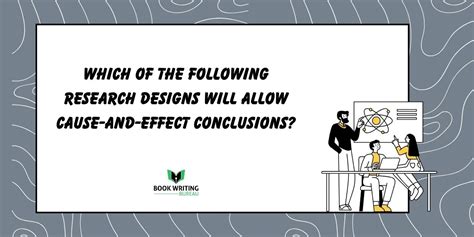Introduction:

Establishing cause-and-effect relationships is a fundamental objective in scientific research. However, not all research designs are equally capable of drawing such conclusions. Understanding the strengths and limitations of different research designs is crucial for selecting the appropriate approach in order to obtain meaningful and reliable results.
Research Designs for Cause-and-Effect Conclusions:
1. Experimental Research:
Experimental research designs are the gold standard for establishing causality. Experiments involve manipulating an independent variable (the presumed cause) and observing the corresponding changes in the dependent variable (the presumed effect). By controlling for other factors and randomly assigning participants to experimental and control groups, experiments allow researchers to isolate the effects of the independent variable and draw causal inferences.
2. Quasi-Experimental Research:
Quasi-experimental designs resemble experimental designs but lack random assignment of participants to groups. Instead, they rely on matching or other strategies to create comparison groups. While quasi-experiments provide stronger evidence for causality than non-experimental designs, they are still susceptible to confounding variables and selection bias.
Types of Quasi-Experimental Designs:
- Non-Equivalent Control Group Design: Compares an experimental group to a non-randomized control group.
- Time Series Design: Repeatedly measures the dependent variable over time, both before and after the intervention.
- Propensity Score Matching: Matches participants in the experimental and control groups based on their propensity to be exposed to the intervention.
3. Observational Research:
Observational research designs involve collecting data on existing relationships without manipulating any variables. These studies identify associations between variables but cannot establish causality due to potential confounding factors. However, longitudinal observational studies can provide strong evidence for causality if they carefully control for confounding variables and follow participants over time.
Tips and Tricks:
- Validate Customer’s Point of View: Ask questions to understand your customers’ needs and preferences.
- Generate Ideas for New Applications: Brainstorm creative ways to use your research findings in practical settings.
Common Mistakes to Avoid:
- Overgeneralizing Results: Do not draw causal conclusions from non-experimental designs without strong evidence to support the assumption of causality.
- Ignoring Confounding Variables: Control for potential confounding factors that may influence the relationship between variables.
- Making Post-Hoc Assumptions: Do not make causal inferences after the fact based on observed correlations.
Applications of Experimental and Quasi-Experimental Designs:
- Medical Research: Testing the effectiveness of new drugs or therapies.
- Educational Research: Evaluating the impact of teaching interventions on student performance.
- Business Research: Determining the effects of marketing campaigns on sales.
- Social Science Research: Assessing the influence of social policies or programs on community outcomes.
Conclusion:
Establishing cause-and-effect relationships requires careful consideration of research design. Experimental and quasi-experimental designs provide the strongest evidence for causality by controlling for confounding variables and providing a basis for isolating the effects of the independent variable. Observational designs can also contribute to understanding cause-and-effect relationships, but their findings must be interpreted with caution due to the potential for confounding factors. Researchers must carefully select the appropriate research design based on the specific objectives of their study and the available resources.
Additional Resources:
- American Psychological Association (APA): Research Design
- National Institutes of Health (NIH): Study Designs
- Encyclopædia Britannica: Research Design
